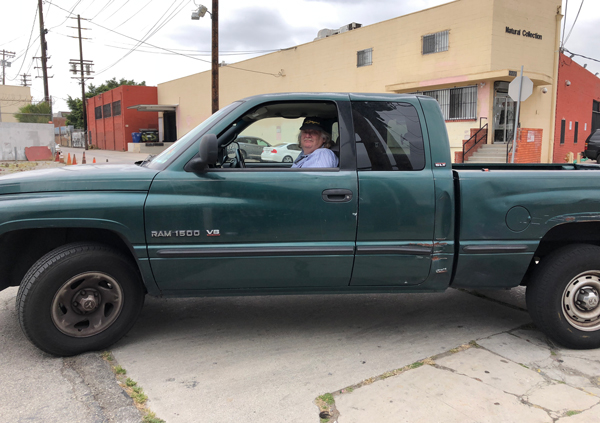On any given Friday, between noon and 2 p.m., you’ll find one of Los Angeles’ best taco trucks parked downtown on 3rd Street in the middle of the Arts District. How do I know this? Because Jonathan Gold says so.
“Let’s meet at Guerrilla Tacos,” the LA Times food critic and man-about-town directs me in a text. Gold has agreed to meet me for lunch while we visit a few galleries nearby. I was especially interested to see the recent gallery arrival from Hong Kong, Over the Influence, whose welcome into the Los Angeles art scene was accompanied by a splattering of red paint all over their front window.
Gold arrives 30 minutes late, but not for the lack of trying; I saw his beat-up ’98 Dodge truck whiz by—at least three times, he informs me later, looking for parking. Finally he saunters up in his signature suspenders, vertical striped button-down shirt and black Converse tennis shoes. His wispy strawberry blond hair flowing from underneath a Langer’s ball cap (the famous MacArthur Park deli) now has strands of white-gray, but hardly noticeable. Immediately the small crowd gathered for lunch takes notice of this inimitable figure. He’s low-key and gets in line to order. The server outside knows him and the chef peeps his head out of the pickup order window to shout a hello. We order one lamb taco and a shrimp quesadilla, with an Agua Fresca for him.
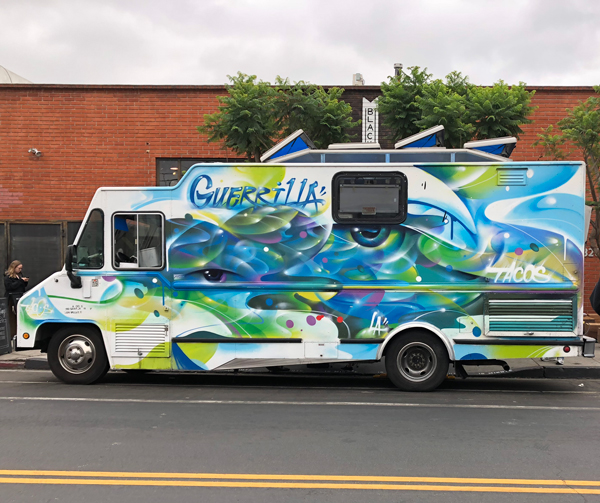
Guerilla Taco Truck parked on 3rd Street
Gold is no stranger to art. He attended UCLA and spent most of his time in the art department despite earning his degree in music. His wife is the arts and entertainment editor at the LA Times. He used to play the cello in a punk band called Tank Burial. And he owns several paintings of mine! I would say he’s a great candidate for gallery-hopping and finding the best places to eat for lunch—a perfect caper for our Food issue. Anyone familiar with his weekly column might imagine Gold as someone who marvels at any form of culture, someone who can offer insight into whatever fine art we might look at. Food and art feels like a natural for Jonathan Gold.
As we take our lunch to the nearby outside benches, I ask Gold if he sees a correlation between food and art. He pauses, “They both turn to shit the next day?” Then more seriously, again, a question to an answer, “They are both ways of looking at the world?” Giving the question one more consideration, he tells me about the restaurant he rated as this year’s best—Vespertine in Culver City, which operates “as a lot of the restaurants on a highest level in the world do at the moment, more on art principles than they do on culinary ones.” In other words, you may or may not like the food, but the chef has this idea that food should put you “slightly at unease,” Gold says. “Someone puts a plate on the table, and you just don’t know what the hell you’re supposed to do with it. Sometimes it’s not obvious.”
Some would argue that describes successful contemporary art. As John Waters famously put it: Contemporary art hates you. Gold rather enjoys this new trend in dining. He has just returned from Japan and relates his experience with a Japanese chef who concocts food out of “tree bark, snails, twigs made out of fish skin, dried soy yogurt to look like mossy soil—everything on it is meant to evoke the spirit of being somewhere else. Like in a patch of woods in the mountains.” In order for the fish to keep that supine lithe figure when served, the chef “puts the fish directly into hot oil, which is something I probably wouldn’t recommend.”
“A live fish?” I exclaim. “Why wouldn’t you recommend it—because it’s cruel?” Gold looks at me with a cool “duh” expression: “Yeah.” I counter, “Yeah, it is cruel, but wouldn’t that be a fast way to die?” With a chuckle Gold responds, “I’m sure it’s a really fast way to die. On the other hand, if someone asked you how would you like to die, I think being deep-fried and served as part of a tasty meal would not be your answer.”
Lunch consumed, we cross the street to Over the Influence, the scene of the crime. Gallery Director Guy Rusha introduces himself and tells us he wasn’t sure what the impetus was for the recent vandalism. He’s not too worried about it; besides, the paint washed off easily. Veteran Japanese artist Nobuyoshi Araki, known for arty S&M photography, mainly women in the compromising poses, was showing during the graffiti attack. Could this be the cause for the red paint? (Araki happens to be currently showing at New York’s Museum of Sex).
Araki’s work fills the massive gallery. Gold thoughtfully looks at all the photos, staying silent. On our way out though, he lingers over one particular image. I look to see what it is and it’s a piece of salmon, cross-sectioned, ready for the grill. It strikes me as funny that Gold stays on that one image after rows and rows of erotica; it is almost sweet, achingly honest. I laugh out loud, then explain to Rusha that my friend is a food critic. Even Gold managed a snicker at that.

Gold with Araki art in the background at Over the Influence.
We stroll down a block to Hauser & Wirth, where Mark Bradford’s new paintings are up. Gold is a fan, so he is glad for the opportunity since the exhibition is soon ending. “This is sort of different for him, right?” Gold remarks as we ponder over the first painting. And Bradford’s paintings do seem fresh, perhaps more painterly. Gold begins to tell me about one of his favorite Bradford works when a Gold admirer interrupts. Gold takes it in stride and is very polite. I gently inquire afterwards how he handles that apparently common occurrence. “If your work touches something in somebody, it’s like, nice,” he responds, then adds cynically, “Even though what I do may be superficial as shit,” referring to his food criticism.
“Do you think art criticism can be superficial too?” “It usually is,” he quips, then quickly retracts his dismissiveness. “But sometimes you’ll see a painting and it’ll be astonishing, [and] if you follow the career over some years, you start to see how tropes and themes and colors, things evolve, and you start to learn something about somebody’s mind, and it’s lovely.” Gold delivers this addendum so earnestly that I can hardly believe he just used the word superficial.

Bradford painting which shape resembles Pakistan.
We loiter more with Bradford’s work. Gold observes a particular painting that seems to have more collage than paint, more erosion, and remarks, “It’s sort of the shape of Pakistan, but maybe not.” He points to another and refers to the “dirty bubblegum” color. (I secretly note not to forget that phrase.)
Gold studies each painting, staying with each work a lot longer than most people would. In the documentary, City of Gold, we see Gold with his two young children at a museum gazing at a painting. We learn Gold makes sure they spend 30 minutes on one piece of art and discuss its qualities, history, references, basically deconstruct it. This is truly a rarity, as the average time a person spends with any piece of art is well under a minute. More than that, it says something about Gold himself; he’s got the sensibility of a critic, no matter the subject.
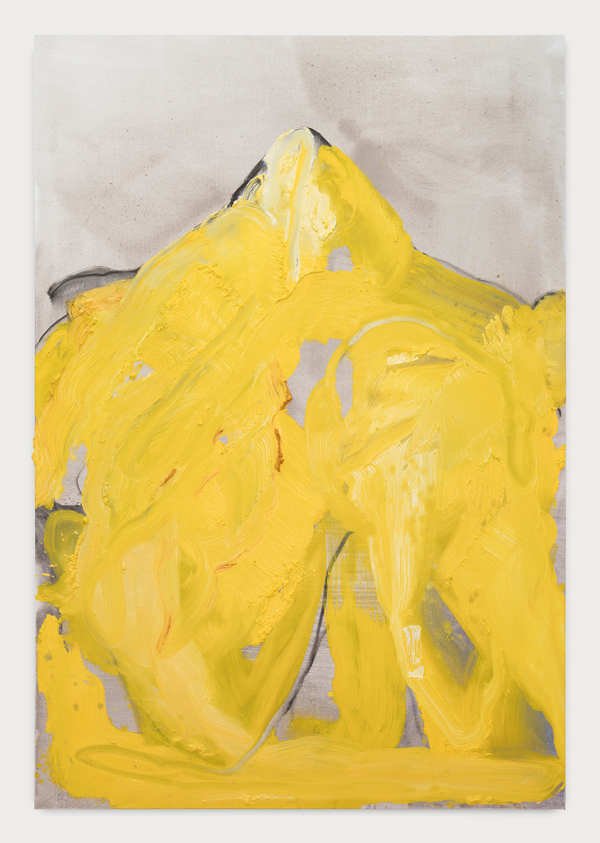
Andy Woll, Mt. Wilson (Passage II), 2018, photo by Nik Massey, courtesy Night Gallery
THE FOLLOWING FRIDAY, Gold agrees to meet me at Night Gallery. I choose this off-the-beaten-path space because it’s one of the hippest galleries in Los Angeles and it shows very good work—but where the hell does anyone eat? The gallery is located in a nondescript dusty industrial district in Southeast DTLA, close to Vernon, close to nowhere. There is one other gallery there, and the rest of the occupants are block-like warehouses with forklifts buzzing around and the constant beeping of semis backing up. Civilization, as art collectors might refer to it, is far away. I was hoping Gold’s expertise could provide a much-needed public service.
We enter the gallery and I pose the dining question to Gold. Sure enough, he’s got a ready answer. “There’s Rossoblu, on the south part of town, it’s maybe a five-minute drive.” He seems to be mulling over other possibilities, but we are drawn to a big yellow abstract painting by Andy Woll on the back wall, or at least I am. I blurt out, “I like these paintings, what do you think?” Gold pauses, then hems and haws and finally says, “I don’t know—what do you think? You liked them, you said.” I think to myself, at least he didn’t say, “Interesting.”

Andy Woll, “Carriagewindow,” 2018, oil on poly coated paper. Photo by Jeff McClane courtesy of Night Gallery.
We talk about the mushroom quality at the top of most of the paintings. The colors are vibrant and the brushwork is fierce. “It’s good. It’s cheerful. It’s a little like Joan, what’s her name?” I guess Joan Snyder. He shakes his head and grabs his phone. “Joan Mitchell!” His comparison to the AbEx pioneer is actually quite a compliment to the artist. We follow a row of same-size paintings, keeping pace when Gold stops, and points to one very abstract painting, “That looks like a clam.” We both laugh—Gold is rolling with my joke, how I think he only reacts to anything that might resemble food.
Just then Alexis Rose, director of Night Gallery greets us. Our observation of everything looking like a mushroom at the top, or the obvious phallus reference of the paintings turns out to be correct. All of the paintings are supposed to be Mt. Whitney, the tallest mountain in California. We walk into the other room to find clay works by Brie Ruais, and Gold seems to brighten up. Most hang on the wall with a few pieces on the ground. All works are the weight of the artist, Rose tells us. She points out indents where the artist might shove her elbow into the clay while making the object. I can tell Gold is much more jazzed with this work. He moves silently from piece to piece, pausing on some more than others, then says, as if he’s come to a decision: “This is good. There’s that moment that sculpture became performance, in the late ’60s, early ’70s. This is like a direction that nobody quite took, it’s nice.”
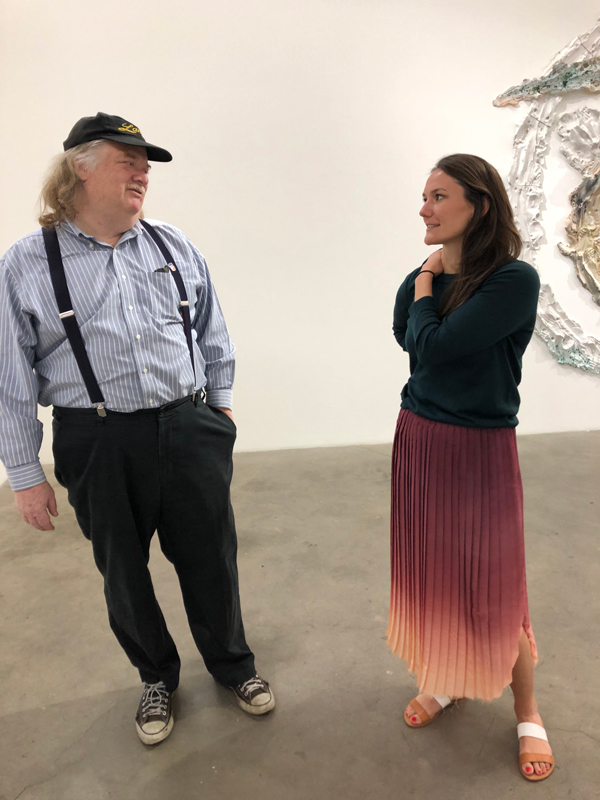
Gold with Night Gallery Director Alexis Rose in front of Ruais’ work.
It’s not entirely surprising that Gold responded to the performative nature of Ruais’ work more than the abstract paintings. Gold worked for the iconic conceptual artist Chris Burden back in the early ’80s when he attended UCLA. He tells me how he majored in music but the department was much more conservative back then. “It turned out people who scored movies, and I realized I was getting more into guys like [German electronic music composer Karlheinz] Stockhausen. In a lot of ways, performance art and Chris Burden had more to do with what I was doing than anyone else.”
Reluctantly Gold poses with me for a picture in front of a Ruais piece . We then head out for some lunch. We are going to Carnitas El Momo’s taco truck in Boyle Heights. Even though, hands down, Mariscos Jalisco’s truck is to die for and where most of the galleries on the Santa Fe strip and Night Gallery go, Gold wants to make sure we get to Carnitas El Momo’s before it closes at 2 p.m. It’s apparent Gold did his homework before our meeting as he is quite pleased to see Momo’s parked when we get there. Gold orders four tacos, with no specification. A pair of chicharrón tacos are first delivered to us and they are fantastic, dripping in orange grease. Gold shows me a trick how to clean greasy fingers after eating tacos—use the limes as sponges. It works!
We eat mostly in silence as Gold seems a little cagier than usual here. He told me earlier he hasn’t formally reviewed them, and seems distracted. I have the feeling he is now in his full critic mode, contemplating every bite we are taking. He is known for visiting restaurants up to a dozen times before writing his review. I wonder how many art critics are as thorough?
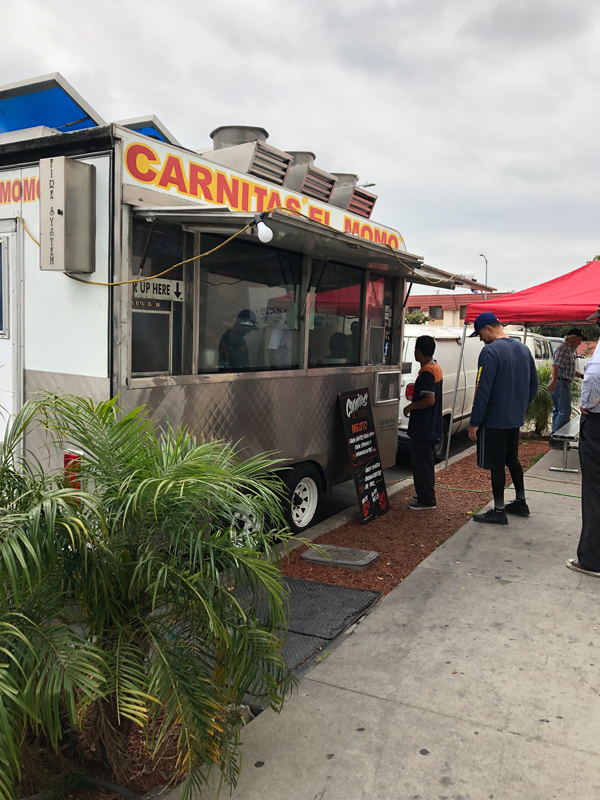
Carnitas El Momo in Boyle Heights
How did Gold end up writing about food, and doing it so well? His trajectory from music major to famous-artist studio assistant to legal proofreader to music writer to Pulizter Prize–winning food critic, is compelling. He told me how at the LA Weekly, “in the mid-’80s, food-writing was not respected. Jay [Levin, founder of the Weekly] thought I was wasting my time. And [film critic John] Powers thought that I was wasting my time. I did other stuff. I wrote about art sometimes. I was a third-string movie critic. All the movies I reviewed had numbers after them,” he laughs, “or they start with the name Cory. But it was fun in a way. You can’t be too serious when you’re reviewing bad sequels or horror movies.”
I asked him if he took the art classes for fun. He objected to that notion, “It wasn’t for fun, I was obsessed with art.”
“Did you think you might want to do art too?” Gold hesitates, “No, I was remarkably incompetent at producing objects.” What about paintings? “God, I took a painting class with Alexis Smith once—and she was so patient with me! Instead of learning how to paint, I’d do stuff like dissolve canvasses with acids,” he laughs. “Conceptually it was interesting, but it was kinda bullshit. I would have given anything to draw a beautiful line, but as you know, it’s really fucking hard to draw a beautiful line.”
Gold reminds me of his personal project, even before he starting officially writing about food, of how he ate at every restaurant on Pico Boulevard. “In a way it was the way I got to know Los Angeles. You’re looking for stuff, and you find yourself in different neighborhoods, and you talk to different people, and it gives you something to talk about.”
Gold could probably be an art critic, and a damn good one. I think he just prefers to nibble and nosh.

